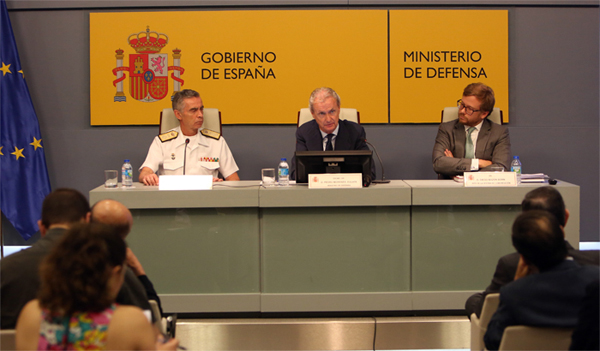- Home
- Latest News
- Full article
Minister of Defence presents ‘Trident Juncture’ exercise
Friday, July 3, 2015
Number: 4410
The minister of Defence, Pedro Morenés, presented this morning the NATO exercise “Trident Juncture”, which will run from 3 October to 6 November. Spain will be one of the countries hosting the exercise, together with Italy and Portugal, and will contribute 8,000 out of the 30,000 participating soldiers.
“This exercise will demonstrate the capabilities of NATO to face any threat,” declared the minister, who pointed to jihadist terrorism and the Ukraine crisis as the main threats currently confronting the Alliance. “This is possibly the most important exercise NATO has conducted to date,” he asserted. Regarding the threat of jihadist terrorism, Pedro Morenés stressed that Trident Juncture “will show those who intend to threaten our way of life that we are willing and able to protect our society and our values.”
Trident Juncture will be overseen by the Allied Joint Force Command based at Brunssum (Netherlands). Soldiers from over 30 countries will take part. The aim is to train and certify the 2016 NATO Response Force (NRF).
The exercise will be divided into two distinct phases. The first phase, from 3 to 16 October, will be a command post exercise to appraise and certify the command structure of NRF 2016. It will take place in Germany, Belgium, Canada, Spain, Italy, the Netherlands, Portugal and the UK, as well as in the Atlantic and the Mediterranean.
The second phase, from 21 October to 6 November, will be a live exercise involving a ground offensive, amphibious landings, parachute jumps, operations in an urban environment, actions by special operations forces, an intervention in an NRBC environment, etc. This phase will be held in several locations in Spain, Italy and Portugal, as well as the Atlantic and the Mediterranean.
20,000 of the 30,000 soldiers taking part in the exercise will be deployed in eight sites in Spain, three of which are under the control of the Army: the training centres “San Gregorio” (Zaragoza) and “Chinchilla” (Albacete) and the training field and shooting range “Álvarez de Sotomayor” (Almería). In addition, the Army will contribute more than 4,700 soldiers, 23 tanks, 93 armoured vehicles and six helicopters – two attack and four transport helicopters. Most of the troops belong to the 7th Light Infantry Brigade “Galicia”.

The minister during the presentation of the exercise (Photo: Iván Jiménez/DECET)
NATO’s Rapid Deployable Corps Headquarters at Bétera (Valencia) will lead the NRF 2016 land component command with a reaction force comprising three multinational brigades. For the first time, this year’s NRF will be able to deploy a Very High Readiness Joint Task Force (VJTF) available to act as a spearhead. VJTF will be a multinational brigade comprising up to five manoeuvre battalions built around a core force provided by the leading country (in this case, Spain) to which other allies will contribute troops.
ARMY UNITS
- Araba Álava |
- Albacete |
- Alicante |
- Almería |
- Asturias |
- Ávila |
- Badajoz |
- Barcelona |
- Burgos |
- Cáceres |
- Cádiz |
- Cantabria |
- Castellón |
- Ceuta |
- Ciudad Real |
- Córdoba |
- A Coruña |
- Cuenca |
- Girona |
- Granada |
- Guadalajara |
- Gipuzkoa |
- Huelva |
- Huesca |
- Islas Baleares |
- Jaén |
- León |
- Lleida |
- Lugo |
- Madrid |
- Málaga |
- Melilla |
- Murcia |
- Navarra |
- Ourense |
- Palencia |
- Las Palmas |
- Pontevedra |
- La Rioja |
- Salamanca |
- Segovia |
- Sevilla |
- Soria |
- Tarragona |
- Santa Cruz de Tenerife |
- Teruel |
- Toledo |
- Valencia |
- Valladolid |
- Bizkaia |
- Zamora |
- Zaragoza



